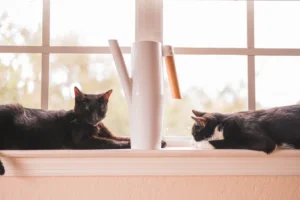Cats, like their favorite spot on the couch, can be territorial, especially when it comes to food. It might seem like a scene out of “The Fast and the Furriest” when mealtime turns into a miniature tug-of-war, claws out and all. This post will explore practical tips and strategies to ensure peace reigns again at the food bowl.
By the end of this read, you’ll know exactly how to calm the storm in the kitchen, turning your cat from a food gladiator into a peaceful diner.
Key takeaways:
- Identify food aggression through signs like guarding behavior, vocalization, and physical aggression to catch and manage early.
- Reduce aggression by feeding cats in separate spaces, establishing a consistent feeding schedule, and using slow feeders or puzzle toys.
- Consult a professional for excessive aggression, changes in eating habits, or if behavioral changes occur outside of meal times for tailored advice and strategies.
What Causes Food Aggression in Cats?
Food aggression in cats can stem from a variety of sources, each with its own backstory and complexities. At its core, this behavior is often a survival tactic, hardwired into a cat’s instincts. For some, especially those who’ve experienced trauma like being stray or having to fight for food, aggression is a learned response to a history of scarcity. In multi-cat households, the competition for resources can trigger these instincts, leading to squabbles over mealtime.
Understanding the reasons behind your cat’s food aggression is akin to unraveling a mystery; it requires patience, observation, and sometimes, a bit of detective work. Whether it’s past trauma, competition, or simple instinct, getting to the root of the aggression is your first step towards resolution.
How Can You Tell If Your Cat Is Food Aggressive?
Recognizing food aggression early can be the key to preventing more serious issues down the line. Here are a few signs that your feline friend might be feeling a bit too territorial about their kibble:
- Guarding behavior: Watch for signs such as hovering over their food bowl, or even encircling it with their body, which can indicate they’re on high alert.
- Vocalization: From low growls to outright hissing, these sounds are a clear signal your cat feels threatened and is ready to defend their meal.
- Physical aggression: Swatting, biting, or chasing other pets (or even humans) away from their feeding area are unequivocal signs of food aggression.
Spotting these behaviors early can give you a head start on mitigation and ensure a peaceful coexistence in your furry household.
What Can You Do to Reduce Food Aggression?
Tackling food aggression in cats requires a blend of strategy, understanding, and patience. Here are some practical steps to help tone down the mealtime mischief:
-
Feed cats in separate areas: This is especially crucial in multi-cat households. Giving each cat their own space can reduce competitiveness and stress. Try using different rooms or, if space is a premium, feeding them at different heights (e.g., one on the floor, one on a countertop).
-
Establish a consistent feeding schedule: Cats thrive on routine. Feeding them at the same times each day can help alleviate anxiety around mealtime, as they’ll trust that food is indeed coming.
-
Slow feeders and puzzle toys: These clever devices not only slow down your cat’s eating pace but also enrich their environment by engaging their brain. A favorite is the Trixie Activity Fun Board, which challenges them in different ways to access their food.
-
Behavioral modification: Positive reinforcement can work wonders. Rewarding calm behavior around food with treats or affection helps associate mealtime with positive experiences.
Here’s the kicker and something you might not find on every blog: Consider the texture and temperature of the food. Some cats might become aggressive if the food is too cold (e.g., directly from the fridge) or if it’s a texture they dislike or struggle with. Warming the food slightly or choosing a more palate-pleasing texture can make a world of difference.
By approaching food aggression with empathy, understanding, and a bit of creativity, you can help your feline friends feel more secure at mealtime. Remember, each cat is unique, so what works for one may not work for another. It’s all about finding the right mix of strategies for your particular pet family.
When Should You Consult a Professional?
Let’s face it, dealing with a cat that gets a bit too feisty around their food bowl can be a hairy situation. While a certain level of assertion over food can be typical among felines, sometimes the line between normal and excessive gets blurrier than a cat in a sprint. So, how do you know when it’s time to wave the white flag and get a professional involved? Here’s the scoop on spotting those red flags and understanding the benefits of seeking help.
Spotting the Red Flags
First up, let’s chat about the signs that it’s time to reach out for professional guidance. Keep an eye out for these behaviors:
- Excessive Aggression: If your cat’s hissing, swatting, or biting becomes more intense or frequent, especially during meal times, it’s a clear sign that professional intervention may be needed.
- Change in Eating Habits: A sudden increase or decrease in appetite can indicate underlying health issues. If your cat goes from zero to sixty at the sight of food or suddenly turns their nose up at their favorite dish, it’s worth a vet visit.
- Physical Symptoms: Keep an eye out for any physical changes in your cat, such as weight loss or gain, lethargy, or signs of discomfort. These could be cues of a deeper issue contributing to their food aggression.
- Behavioral Changes Outside of Meal Times: If you notice your cat exhibiting aggressive or overly protective behavior in other scenarios, not just around food, it might be part of a larger behavioral pattern that needs addressing.
The Benefits of Professional Help
Now, let’s talk turkey about why bringing in the pros can make a world of difference.
Veterinarian Insight
A veterinarian can rule out or treat any underlying health issues that might be causing your cat’s food aggression. From dental pain to gastrointestinal problems, several medical conditions can make mealtime stressful for your furry friend. A thorough examination, possibly including blood work or imaging, can provide invaluable insights.
Behaviorist Strategies
A certified cat behaviorist or animal psychologist comes equipped with an arsenal of strategies to alleviate food aggression. These professionals can offer:
- Tailored Training Techniques: Every cat is unique, and a cookie-cutter approach just won’t cut it. A behaviorist will work closely with you and your cat to establish a personalized training plan.
- Environmental Modifications: Sometimes, changing the feeding environment can significantly reduce food aggression. A behaviorist can suggest practical changes to your cat’s eating area to make mealtimes more peaceful.
- Ongoing Support: Tackling food aggression can be a journey, and having a professional to guide and support you through the process is invaluable.
A Nugget of Advice Most Miss
Now, for a piece of unique advice – many experts and blogs miss emphasizing the importance of multiple slow-introduction sessions for households with more than one pet. It’s not just about separating your pets during meal times; it’s about gradually introducing them to eating in the same space while maintaining a comfortable distance, thereby reducing territorial aggression over time. This method takes patience and consistency but can pave the way for harmony at the food bowl.
Wrapping Up
Remember, reaching out to a professional isn’t a sign of defeat; it’s a proactive step towards ensuring the well-being of your beloved cat. Whether it’s a vet visit to address potential health issues or consulting with a behaviorist for tailored strategies, the expertise these professionals offer can transform mealtime from a battlefield to a peaceful gathering. Keep an eye out for those red flags, and don’t hesitate to seek help. After all, your furry companion deserves to enjoy their meals as much as we do ours.
Alex, a passionate animal lover, has experience in training and understanding animal behavior. As a proud pet parent to two dogs and three cats, he founded AnimalReport.net to share insights from animal experts and expand his knowledge of the animal kingdom.





